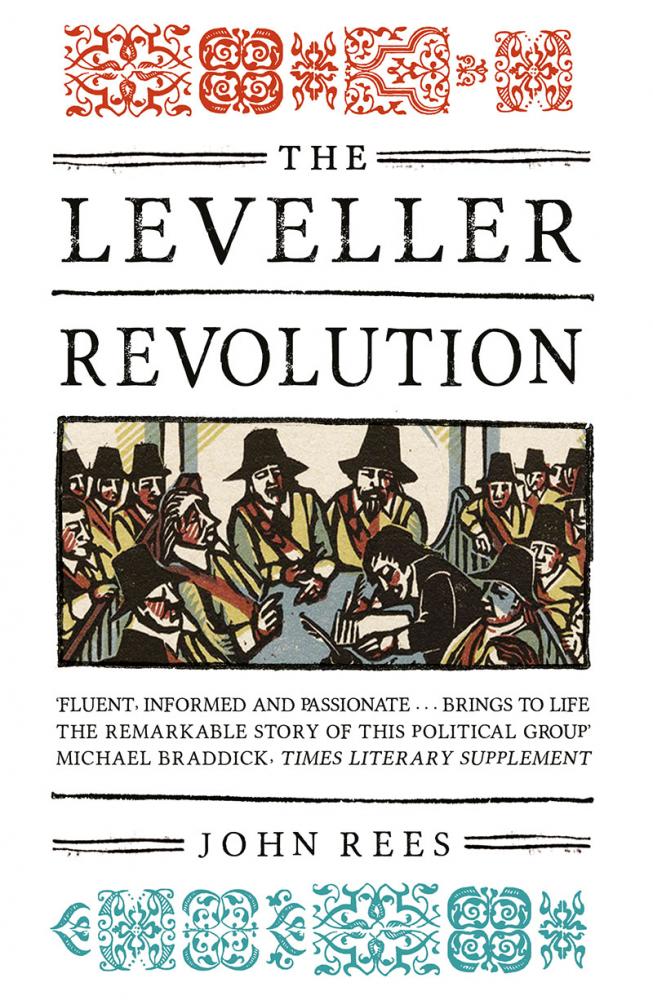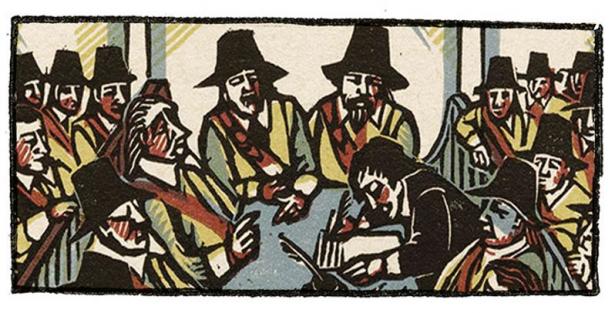In 1649, a pamphlet titled Tyranipocrit Discovered was published in Rotterdam. Fusing the terms “tyrant” and “hypocrite,” the anonymous author called for an end to economic, religious, and political oppression in England. The writer claimed tyrants who ruled the country robbed the poor through the monopolization of land and exploitation of labor, while hypocritical clergy justified the people’s impoverishment from the pulpits of the national church. However, since “God through nature had formed all men alike” economic and social inequality were contrary to “reason.” An equal distribution of wealth, political power, and education was by contrast consistent with nature and reason, and such a revolutionary transformation would make possible “universall freedome” for “all mankinde.”
Tyranipocrit stands as an eloquent expression of radicalism during a revolutionary decade. At the beginning of the 1640s a political crisis between Parliament and King Charles I led to the breakdown of state control over the press, which was followed by an explosion of new ideas in print. After the beginning of civil war between parliamentarians and royalists in 1642, some radicals began to question the need for a national church altogether, leading to a division within the parliamentarian movement between Presbyterians (who favored a hierarchical national church system) and Independents (who favored autonomy in local churches and religious freedom). By 1646 and 1647 democratic, and by the end of the decade even socialistic, pamphlets and petitions were published in London.
The climax of the Revolution came in 1648-9, with the defeat of Charles in August of 1648 and the king’s subsequent trial for treason against the people and execution. Over the course of 1649 the House of Lords (the unelected upper house of Parliament) was abolished, the Church of England was disestablished, and a republic—the Commonwealth of England—was created. For many supporters of Parliament, however, the revolution had not gone far enough. Some activists and writers (like the author of Tyranipocrit) demanded more sweeping political, economic, and religious transformation.
The revolutionary government therefore began a campaign of repression against groups like the Levellers, a radical democratic organization with whom the author of Tyranipocrit clearly sympathized. (Some historians believe the well-known Leveller William Walwyn was the pamphlet’s author.) Leaders were arrested and their writings were suppressed while army mutinies were crushed by the Puritan military leader Oliver Cromwell. In the early 1650s England undertook military aggressions in Scotland, Ireland, and the Americas, and in 1653 Cromwell became Lord Protector of England, essentially creating a military dictatorship. In 1660, two years after Cromwell’s death, the monarchy was restored under Charles Stuart II. England’s republican experiment was over.
The Leveller Revolution: Radical Political Organization in England, 1640-1650
By John Rees
Verso Books; 512 pages
November 29, 2016
Hardcover: $13.98; Paperback: $13.98 w/ebook
HB ESPN: 9781784783884;
PB ESPN: 9781784783891;
EB ESPN: 9781784783914

While much has been written about the English Revolution and the Levellers, John Rees’s The Leveller Revolution: Radical Political Organisation in England, 1640-1650 (Verso, 2016) is an essential book for those interested in revolutionary history as well as for activists concerned with questions of organization and strategy today. The Leveller Revolution’s stated aim is to allow readers new to the period to enter into the world of seventeenth-century England, and Rees’s argument is that this pioneering revolutionary group “arose out of wider currents of radicalism and through a process of differentiation with both opponents and allies they came to form a distinctive political organisation.” The book provides a fascinating bottom-up narrative of radical political organization during a decade in which the world was truly “turned upside down.”
Some of the wider currents of radicalism indispensable to Leveller organization explored by Rees include London apprentices, military radicals (known as “Agitators”), religious dissenters, and a network of underground printers that would make possible the dissemination of Leveller ideas to a wide audience. The city of London itself plays a vital role in Rees’s story. Specific locations in London “constantly recur in the story of the Levellers as locations of gathered churches, the homes of revolutionaries and the hiding places of secret presses.” It was in the English metropolis that different radical currents came together and evolved in the revolutionary process.
One of the virtues of Rees’s focus on organization and his placement of the Levellers in a wider social context is that, in addition to famous leaders like John Lilburne, Richard Overton, and William Walwyn readers meet lesser known—though crucial—Leveller supporters like Katherine Chidley. At a time when women were considered by mainstream thought to be the inferior sex, Chidley’s writings and activism place her as a pioneer of women’s pubic involvement in religion and politics. Indeed, for many opponents of revolutionary radicalism—including conservative supporters of Parliament—in the 1640s it was women and other “mechanick preachers” (working-class writers and speakers) who posed the primary threat to the established order. Chidley and other Levellers were the political vanguard of this threat.
The Levellers did not emerge as a coherent group until 1645-6, though the organization’s core leaders had long been active in London. The frequent jailing of Lilburne was a crucial rallying point for early Levellers and their sympathizers, and the publication of pamphlets and petitions in support of “freeborn John” were essential in creating this grassroots support. In 1646, A Remonstrance of Many Thousand Citizens, authored by Overton and Walwyn, was simultaneously a petition occasioned by Lilburne’s imprisonment and a founding statement of Leveller principles. Addressed to the House of Commons, the Remonstrance claimed members of Parliament were mere servants of the public and were obliged to do the people’s bidding—an assertion of popular sovereignty as radical as the suggestion the English people should worship as they thought fit. A political movement rooted in the principles of natural equality and government by consent—the first in history—was born.
The New Model Army, established by Parliament in 1645, was ordered to disband in 1647 after the victory over Charles in the “first” Civil War. Not only did soldiers refuse to demobilize—they proceeded to elect their own representatives, and many of these Agitators were allied with the Levellers. The Leveller manifesto An Agreement of the People was the subject of the Putney Debates, the famed meeting between pro-Leveller Agitators and “Grandees,” Independent military leaders Oliver Cromwell and his son-in-law Henry Ireton, in late 1647. Cromwell and Ireton believed only men of wealth should be allowed to vote and thought the Agreement’s democratic demands would logically lead to threats to property. This led Agitators like Edward Sexby and Leveller spokesperson Colonel Thomas Rainsborough to question what ordinary soldiers had been fighting for. In a legendary democratic declaration Rainsborough stated:
I think that the poorest he that is in England hath a life to live, as the greatest he; and therefore truly, Sir, I think it’s clear, that every man that is to live under a government ought first by his own consent to put himself under that government; and I do think that the poorest man in England is not bound in a strict sense to that government that he hath not had a voice to put himself under.
Though the Agitators, and Leveller hopes, were soon defeated by the Grandees, the Second Civil War (1648-9) further polarized the nation, making possible Levellers’ influence as a serious political power. For Rees, a new alliance between Levellers and moderate Independents, together with an intensified publication strategy, was essential to Parliament’s ultimate victory. The funeral of Rainsborough, assassinated (probably by royalists, though some believe conservative parliamentarians—perhaps even Cromwell—may have played a role) in late October, became a mass Leveller-led demonstration as thousands of mourners wearing the Leveller color of sea-green paid tribute to the colonel. A flood of pamphlets and more demonstrations characterized 1648, a year in which Leveller power peaked.
The alliance between Levellers and Independents did not last, however. After Charles’s execution and the abolition of the House of Lords the “the political bloc that had accomplished the Revolution’s victory shattered on the rock of its own success.” Some Levellers, notably Walwyn and Lilburne, were critical of the new regime; others were placed in positions of authority in the new republic. Grandee leaders like Cromwell (“Silken Independents”) were put on the defensive by a radical pamphleteering offensive against the government; the regime responded by aggressively moving against the Levellers. As the movement’s leaders were arrested, former allies like religious dissenters began to support mainstream Independency since freedom of worship was won with the creation of a republic. While Levellers remained active in print and in army mutinies and Leveller activists continued to write and agitate into the 1650s, by the end of 1649 the movement was effectively destroyed.
Toward the end of the book Rees addresses theoretical and historiographical issues raised in his narrative. In the view of this reviewer arguments over whether the English (or French, or American) Revolution was a “bourgeois” revolution are not particularly useful. More important is Rees’s compelling refutation of revisionist historians’ rejection in recent years of the Levellers’ significance to the Civil Wars. As Rees convincingly shows, Levellers’ ability to adjust to rapidly changing circumstances and make alliances allowed them to contribute substantially to the outcome of events in the 1640s.
This claim is related to the contemporary relevance of the Levellers. Rees argues that although the Levellers were not a majority organization or a political party (these did not exist in the modern sense), groups with “a relatively small social weight can have a decisive political impact.” In repeatedly drawing attention to Levellers’ ability to adapt to the contingencies of the revolutionary process, Rees suggests astute political maneuvering can allow small organizations to have important influence. Is Rees implying that minority socialist movements can, in Leninist (or apparently Leveller) fashion, seize the revolutionary initiative in certain moments today? Can socialist organizations work with other progressive groups to bring about radical social transformation through peaceful means? Or must revolutions in capitalist society be worker led in order to be successful?
Works like The Leveller Revolution help to address such questions of strategy with historical examples in interesting and novel ways. Rees’s ability to fuse incisive analysis with narrative skill only adds to the book’s appeal. Whether or not democratic socialists will agree with every argument Rees makes, The Leveller Revolution should be on every leftist’s bookshelf.
Book author John Rees is an historian, broadcaster and U.K.-based political activist. Co-author of A People’s History of London and other titles, he is a visiting research fellow at Goldsmith’s, University of London and a national officer of the Stop the War Coalition.
[Essayist Daniel Johnson’s writings have appeared in New Politics, Against the Current, Jacobin, and Monthly Review. He teaches in the Department of American Culture and Literature at Bilkent University in Ankara, Turkey.]


Spread the word